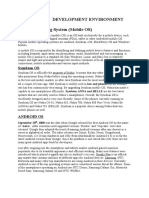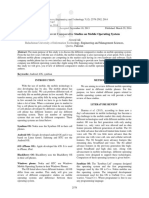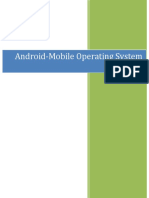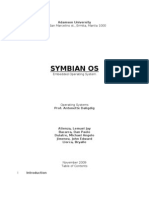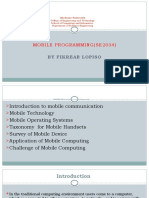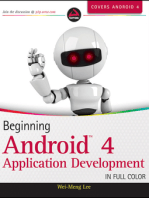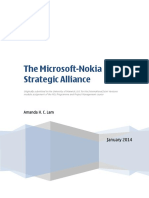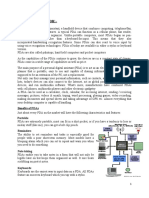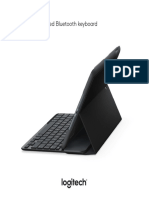Android Vs Symbian
Android Vs Symbian
Uploaded by
Rana Faheem ZahidCopyright:
Available Formats
Android Vs Symbian
Android Vs Symbian
Uploaded by
Rana Faheem ZahidOriginal Description:
Original Title
Copyright
Available Formats
Share this document
Did you find this document useful?
Is this content inappropriate?
Copyright:
Available Formats
Android Vs Symbian
Android Vs Symbian
Uploaded by
Rana Faheem ZahidCopyright:
Available Formats
Android VS Symbian: The battle of dominance
I. Abstract:
The following article is a review paper that gives an introduction to the new mobile platform
Android as well as a comparative evaluation with regard to other mobile operating systems i.e
Symbian OS. The key topic of this thesis is the categorization of Android and Symbian. Therefore
it first gives a historical introduction to cell phones and mobile operating systems. Then it
describes the main features of Android and Symbian for a better understanding of this platform.
In the following theoretical part there will be comparison between Android and Symbian OS.
Features and criteria defined in this part will be considered and included in the comparison of
these systems. The practical part contains a comparison of the Software Development Kits (SDK)
from Android and Symbian OS. In this context a simple application implementation on both
systems is realized to support this comparison. Finally an outlook and a conclusion complete this
elaboration.
II. Keywords:
Android, Symbian, Nokia, Operating System (OS), PDA, UI (User
Interface), Firmware
III. Introduction:
A mobile operating system (mobile OS) is the operating system that
controls a smartphone, tablet, PDA, or other mobile device. Modern mobile operating systems
combine the features of a personal computer operating system with touchscreen, cellular,
Bluetooth, Wi-Fi, GPS mobile navigation, camera, video camera, speech recognition, voice
recorder, music player, near field communication, personal digital assistant (PDA), and other
features.
Some of the operating systems are Android, Symbian, iOS, Bada OS, Black Berry OS etc.
From 1979 to 1992 the mobile phones used the embedded systems to control the operations. But
in 1993 the first smartphone, the IBM Simon, had a touchscreen, email, and PDA features. Then
there came the era of mobile operating systems because these operating systems seemed to be
convenient as they were flexible to use and also they provide much freedom to developer a well
as user to be amused with UI.
Symbian OS
The smartphone operating system Symbian OS is produced by the software developer and
licensing company Symbian Ltd. Symbian Ltd was established in June 1998 and has its
headquarters in Southwark, UK, and the current CEO is Nigel Clifford. Symbian was previously
owned by Nokia, Ericsson, Sony Ericsson, Panasonic and Samsung, on the 24th of June 2008
however Nokia announced it would acquire Symbian Ltd. Now, on this day, Nokia is the one and
only owner of Symbian. Symbian OS offers a highlevel of integration with communication and
personal information management (PIM) functionality. As a smartphone operating system,
Symbian can provide many applications and services such as; navigation, games, music
playback, associated libraries, etc. Symbian was designed for mobile devices from its earliest
incarnation as EPOC32 in the Psion Series 5. Symbian OS was designed from the ground up for
mobile communications devices. While some competing operating systems (such as Microsofts
Smartphone OS) evolved from operating systems written for larger, more resource-laden
systems, Symbian OS approached it from the other direction. Symbians earlier versions (known
as EPOC) would run on devices with as little as 2MB of memory. Symbian OS is a multitasking
operating system with features that include a file system, a graphical user interface framework,
multimedia support, a TCP/IP stack and libraries for all the communication features found on
smartphones. Symbian OS has software development kits available for third-party application
development. Also, the hardware layers of the operating system are abstracted, so that phone
manufacturers can port the OS to the specific requirements of their phone
Android OS
The term Android has its origin in the Greek word andr-, meaning man or male and the
suffix -eides, used to mean alike or of the species. This together means as much as being
human. Android is a software stack for mobile devices which means a reference to a set of
system programs or a set of application programs that form a complete system. This software
platform provides a foundation for applications just like a real working platform Android is a
Linux-based operating system for mobile devices such as smartphones and tablet computers. It is
developed by the Open Handset Alliance, led by Google, and other companies. Android, Inc.
was founded in Palo Alto, California, United States in October, 2003 by Andy Rubin, Rich
Miner, Nick Sears, and Chris White. It was the open public license and five years after the
invention of the Symbian the foundation of Android OS was laid in 2005 and the first Droid
phone was the HTC Dream launched in 2008. During these five years of time span some other
mobile OS were introduced. Android has a large community of developers writing applications
(apps) that extend the functionality of the devices. Developers write primarily in a customized
version of Java. Apps can be downloaded from third-party sites or through online stores such as
Google Play (formerly Android Market), the app store run by Google. In October 2011, there
were more than 500,000 apps available for Android, and the estimated number of applications
downloaded from the Android Market as of December 2011 exceeded 10 billion. Android was
listed as the best-selling smartphone platform worldwide in Q4 2010 with over 300 million
Android devices in use by February 2012. According to Google's Andy Rubin, as of December
2011, there were over 700,000 Android devices activated every day.
IV. Methods:
In this article the comparison between operating systems is based on the ease and better user
interface that these two operating systems provide to its users. The ease of development of the
apps of both operating systems is also concerned. The statistics of public opinion is also the key
to compare Android and iOS.
V. Results:
The results are discussed on the basis of following key points:
Portability:
Portability is a very important assessment criterion. Symbian OS has many references in this
area and is used on many cell phones and smart phones today. Because of the standardized
architecture and the openness to software from other manufacturers a wide field of operations
is available. The Android Mobile platform is a Linux based system and has the big advantage
that this operating system can be used on many different platforms. The open access will help
to collect a lot of experience which will make it easier in the future to access other sections.
The fact that Android is Android vs. Symbian OS based on the standardized programming
language Java, which is also used for application development, underlines the importance of
portability for this platform. The fact that Symbian mostly runs on Nokia cell phones and that
it is not Java based lets it fall behind Android. As a result Android gets upper hand as
compared to Symbian OS.
Reliability:
Reliability is very much dependent on user experience. An operating system can be tested
extensively, but without having experience of several years in the real world it is very hard
to give a good estimate.
All operating systems consist of around one million lines of code. Another study which is
also taken from the above article deals with the amount of bugs to be found in executable
code in average following this study the Linux kernel has probably something like 15,000.
The large size of current operating systems and the big amount of bugs being in every
operating system show that it is not possible to understand the whole system as well as to say
that the system is totally reliable. Because of many years of user experience and the amount
cell phones working with each of the systems it is possible to say that both, Symbian OS is
reliable enough for all kinds of users and applications which are available at the moment. It
doesnt mean that Symbian OS system runs perfectly well but problems with the system will
not result in major difficulties. Android is available on cell phones at the moment it is
possible to say if the system will be reliable or not. The Linux kernel, used by Android, has
existed for more than a decade and has proven that it is stable and fail-proof. Therefore it is
useful for mobile applications. Nowadays it is often used on Webservers or similar
applications which require a high degree of reliability. So I think it is possible to say that
Android will not rank behind Symbian OS regarding reliability. Regardless to the openness
of the Android and as it controls the major portion of the cell phone market Android is more
reliable than Symbian OS.
Connectivity:
There are many ways to connect a cell phone to other devices, such as personal computers,
the internet or other cell phones. Although we have the possibility to connect our cell phone
via cable with the other devices, the mobility of a cell phone generally make a wireless
connection preferable.
Therefore we only deal with wireless connection in this section. This can be wide area, like
connecting to the internet, or personal area which includes infrared and Bluetooth links. The
operating system has to feature applications that are designed to support all the requirements
as well as multi-tasking and the most important communication protocols. Symbian OS
features GSM telephony, Bluetooth, Infrared and WI-FI. The Symbian OS APIs enables a
development that targets all of these features and categories. Android features GSM
telephony, Bluetooth, EDGE (technique to increase the data rate in GSM mobile network),
3D (third generation mobile standards), and WI-FI. All developers have the same access to
the framework APIs used by the core applications.
Android vs. Symbian OS Also with regard to this criterion it can be said that both operating
systems act on the same level in most of the cases. All of them support the common and
mainly used connectivity standards.
Product Diversity:
Product differentiation is not just a design matter of the operating system. Today a provider
of a product has to make sure that it is possible to innovate and develop new product lines.
All two providers of operating system which are Symbian and Google (Android) have
contact to phone manufacturers who are active participants in software development and help
to extend the operating system. This helps to develop new functionalities and applications
very fast and enhance the whole system. The most important feature concerning product
diversity is to make the relevant product open to the market for development which
guarantees product diversity. This product diversity is equally found in Symbian OS and
Android.
Open Platform:
An open platform can be defined as:
An open mobile platform is a software stack, including an operating system, middleware
and key applications, which can be used on every mobile device. It allows users to develop
additional software and change or replace functionality without limitations. The most
common standards for communication and connectivity are used. All these functionalities
have to be free of charge.
On the basis of above definition of Open Platform Android is certainly the winner as
compared to the Symbian OS as there are some restrictions on Symbian OS as compared to
Android.
Kernel Size:
An often used assessment factor for comparing the kernel size is the Memory footprint
which is the amount of memory used by the operating system. For a significant classification
we need to find the operating system with the lowest Memory Footprint which in turn
maximizes the performance of the operating system. Symbian OS has about 200 Kbyte
minimal memory requirements. The Android operating system which is a Linux kernel will
need about 250 Kbyte. All the data above apply to an installation with the basic and minimal
functionalities possible. As a result Symbian OS needs less memory than Android. So
Symbian gets upper hand on the basis of Kernel Size.
Standards:
Standards in general make the platform more open and attractive for developers. If standards
exist it is easier for everyone and especially for developers, to get to know the new system.
Therefore we need
Standard for internationalization like Unicode,
Standardized programming language like Java,
Standardized network protocol like TCP/IP,
Standard for sending text messages and multimedia messages like SMS and MMS,
Standard for data communication between devices like Bluetooth, Infrared or WIFI,
Standard which helps to make internet content visible for slow data rates like WAP,
Standard for data synchronization like SyncML.
Most of the major standards are supported by all two of the operating systems. Every
operating system uses the most common standards concerning networking, e-mails,
messaging and communication, but only Android is based on the standardized programming
language Java. This is also the only programming language used to develop applications. The
advantage of Java is that its programs can run on any platform without having to be
rewritten. This is also a positive aspect of portability. As a result Android gets upper hand in
this particular regard.
Security:
Symbian OS offers a new platform security architecture which provides a platform with the
ability to defend itself against malicious or badly implemented programs. The architecture
consists of two high level components: Certificate management and Cryptography.
These two modules form the basis for a number of high level components which include
Certificate management control panel item, Software installation and secure
communications. Android is a multiprocessing system, where each application (and parts of
the system) runs as its own process. Most security between applications and the system is
enforced at the process level through standard Linux facilities, such as user and group IDs
that are assigned to applications. Additional finer-grained security features are provided
through a permission mechanism that enforces restrictions on the specific operations that a
particular process can form. Every platform has its own security model that covers the most
important actions concerning software installation. But as far as security is concerned due to
my personal experience Symbian is better than Android.
Special Features:
This section deals with features or applications which are designed to make the system
unique. The Android mobile platform has significant advantages in this case. The new
integrated browser based on the open source WebKit engine allows to access web pages
through the internet the same way as through the PC. Also the virtual machine Dalvik
optimized for mobile-devices are a feature which enables every application runs in its own
process. This is very important for stability and reliability issues. Symbian OS however has
no special features which must be mentioned in my opinion. The communication with the
Internet and the Personal Computer will play a major role in the future with regard to mobile
platforms. Therefore Android is on upper hand in this particular regarded.
VI. Discussion:
The comparison of firmware between android and symbian shows a good deal of difference.
Operating System
If you are a Symbian user and want to upgrade the firmware installed on your device then
you will have to buy a new phone for yourself. But if you are an android user and want to get
a new version of your firmware then you only have to do a software upgrade using your
phone or using a computer and you will have the new features installed replaced by the old
ones.
Flashing Your Phone With New Firmware
If you are a Symbian user and hate the looks of your phones menu style then you have 2
options to change those looks
a) Install a new theme for your phone or
b) Flash your phone with new firmware or rom by using a computer now everybody knows
this is a risky procedure and if anything goes wrong your phone will be dead.
But if you r an android user and want to do the same then you have 3 options
a) Either install new theme
b) Either installs new menu launcher
c) Flash your phone with new custom firmware
you will need to download a new firmware or rom from internet and flash it using your
phone only by just using the recovery menu of your phone and if anything goes wrong and
your phone is dead then you can actually get back your phone in working condition from the
recovery menu itself.
Its as simple as clicking the button and everything in your phone will be like before nothing
ever happened and all this can be done from your phone itself and there is no need of looking
at the computer.
Changing Phone Features
If u use a Symbian phone and want to change the way your menu looks, the way your gallery
looks and your videos and music library looks and your notes and documents and messages,
mms, and phone book looks the way your browser and file manager looks.
Then you can download and install new applications available out there and use them for the
purpose but that will take all your precious phone memory and also will not act as your
default application. If you dont want this to happen then you can find a custom firmware for
your phone that will satisfy all your needs and flash it but thats risky as we saw before.
But in an android you can actually do little tweaks and tricks by removing your default file
browser and downloading and installing new file browser. That is not a risky stuff no
memory eaten by an extra useless application that you dont need and the new downloaded
application will act as your default application.
Processor
Processor is very important to run high end applications. In a Symbian phone you cannot see
what speed your processor runs on.
In an android there are some applications that not only gives you look of your processor
speed but also can help you control it and help you save your battery by going to minimum
speed or help you run high end applications on your phone smoothly by going to maximum
speed.
Modifications
Symbian phones do not allow users to do modifications with their phones. But if you bought
a phone its yours, its not Nokias phone anymore.
Android allows you do this thats why android people say its your phone now so go ahead
and do anything you want.
Telco Network
Android has made its handsets a Wi-Fi hotspot. With a support to wireless Internet, this
operating system can run Web on your handset even when you do not have a network
connection in your phone. You can simply get a wireless connection from some other device
to serve the purpose.
Symbian does not have an integrated network accelerator, for smoother and clearer video
calling, but you can download one and use to speed up the connection for uninterrupted
networking.
Applications
With Android operating system, the users can access thousands of applications, which is
essential for the smart phones. Being an open source platform with relatively closed
development, Android offers several applications. However, being an out-n-out open source
OS Symbian offers huge range of third party apps.
Multimedia
Both Android and Symbian based mobile phones support good multimedia features. The
media players can play diverse music and video files, while there are high mega pixel
cameras as well. However, the images appear better on the Android based touch screen
phones.
VII. Conclusion:
In section of Results the Android platform and Symbian OS were compared with regard to
the main criteria for a mobile operating system. Every criterion was explained in detail and
applied to the two operating systems.
With regard to the main criteria the new Android mobile platform gets most significance. It is the
only truly open system which makes the major difference in my opinion. Also the special
feature like the Web browser and the virtual machine Dalvik play a major role in this
comparison. Standards in connectivity, portability and security are more or less achieved by
every operating system in the same way.
The normal user who uses only the basic applications provided by the cell phone.
The advanced user who uses a large part of the provided applications.
The expert user who tries to get deeper into the cell phone environment develops
applications and uses the total band of functionalities provided by the cell phone.
These groups will now serve as example groups. They represent a large number of users. It
should be said that all operating systems have a very high standard and can be used by every
user group. No company develops an operating system for cell phones which is usable only
by a special group of users. A successful product must meet the needs of all user groups.
The normal user needs an operating system with which he is familiar. Options to configure
the system as well as develop applications for it are not necessary. Important is a good
documentation, easy and familiar usability/handling and just the basic features like
telephone, SMS or camera usage.
All these features are supported by all three operating systems.
The Advanced User needs an operating system that offers not only the basic features like
SMS, telephone or camera usage, he needs functionalities which allow the advanced usage of
the system as defined above. Advanced usage includes functionalities like data exchange,
synchronization and usage of applications like calendar or e-mail synchronization programs.
Also design and usability features are very important for this user as well as technical criteria
like multitasking. This allows e.g. to hear music and check e-mails at the same time. For this
user it is very hard to find an adequate solution. Every operating system seems to be
appropriate. Depending on the operating system he uses for his personal computer (which
will most of the time be Windows) I would recommend Symbian OS. Calendar or e-mail
programs like Outlook will be updated very easily through a standardized program which is
already on the cell phone. Because Android is not (in my personal experience) for those
kinds of people.
The Expert User needs an operating system that offers not only the basic features and tools.
In addition he wants to discover the operating system, find solutions for common problems
like data exchange and tries new ways. He also attaches much importance to design and
wants to use his cell phone like a computer. Also personalization of the operating system
which includes changes with regard to the operating system as well as own developed
applications are very important for this user. A very good documentation is also not required,
because he likes to try things out. Technical criteria like memory requirements, multitasking
and power management are of particular importance.
The right choice for this user is only the mobile platform Android. This operating system is
the only truly open system which allows major changes inside the operating system and
offers common basic standards for programming. Also the new Web browser which allows
the usage like a normal PC based browser is important.
It is again important to realize that all operating systems can be used by everybody because
all operating systems meet the requirements of a modern mobile operating system. The
Android will be more challenging for the user compared to the other two systems while there
is little experience with it at the moment. Therefore it provides for new features like the web
browser. This fits perfectly to the present general trend and could therefore attract many
users.
The above findings suggest three conclusions:
There is not (yet) the ideal mobile operating system, but their usefulness differ in relation to
user requirements. So users should be aware of their requirements and the functionalities they
really want and then choose the adequate operating system.
Android can a big threaten the market dominance of the other system when it achieves
more practical experience and the system is further developed. Then it will have the potential
to become attractive not only to the expert user, but also to the normal and the advanced user.
This could make the mobile operating systems Symbian OS superfluous.
We have seen that the requirements of the user groups as defined above are much different.
Producers of cell phones could be well advised to differentiate their cell phones according to
user groups in order to meet their specific requirements.
VIII. References:
www.google.com
http://en.wikipedia.org/wiki/Android_%28operating_system%29
http://en.wikipedia.org/wiki/Symbian
Thesis by Benjamin Spekmann
www.androidforums.net
en.paseban.com/android-vs-symbian/
techtips.salon.com/android-os-vs-symbian-20375.html
spystudios.com/android-vs-ios-a-usability-battle/
www.nokia.com/support
www.android.com
You might also like
- Kelly Tia ch8 StartDocument2 pagesKelly Tia ch8 Startapi-350785820No ratings yet
- Why Android: A Case Study of Smartphone Operating Systems: AbstractDocument4 pagesWhy Android: A Case Study of Smartphone Operating Systems: AbstractAravindhNo ratings yet
- Unit Iv Development Environment Mobile Operating System (Mobile OS)Document21 pagesUnit Iv Development Environment Mobile Operating System (Mobile OS)Vani BaskaranNo ratings yet
- A Comparative Study Between The Android and Symbian Operating SystemsDocument6 pagesA Comparative Study Between The Android and Symbian Operating SystemserpublicationNo ratings yet
- Mobile Operating System: Presented byDocument21 pagesMobile Operating System: Presented bygauravNo ratings yet
- A Review of Different Comparative Studies On Mobile Operating SystemDocument5 pagesA Review of Different Comparative Studies On Mobile Operating Systemjose miguel ValeraNo ratings yet
- Mobile Operating SystemDocument160 pagesMobile Operating Systemcsestaff23No ratings yet
- Research Article A Review of Different Comparative Studies On Mobile Operating SystemDocument5 pagesResearch Article A Review of Different Comparative Studies On Mobile Operating SystemrameezaranaNo ratings yet
- Review Paper123Document9 pagesReview Paper123vaishnavi biradarNo ratings yet
- Mobile Operating SystemsDocument5 pagesMobile Operating SystemsSohaib JamilNo ratings yet
- chap1_INTRODUCTION_TO_MOBILE_OSDocument15 pageschap1_INTRODUCTION_TO_MOBILE_OSAwal MamaneNo ratings yet
- Os Research PaperDocument6 pagesOs Research PaperMadhuri GhadgeNo ratings yet
- Chapter IDocument13 pagesChapter IBalaji giriNo ratings yet
- Maanasa ChaayaDocument13 pagesMaanasa ChaayaTrina LokNo ratings yet
- Mobile Application DevelopmentDocument130 pagesMobile Application Developmentkavitha100% (1)
- Mad Unit 1Document21 pagesMad Unit 1Abhijay TambeNo ratings yet
- Evaluation of AndroidDocument2 pagesEvaluation of AndroidvvkheradkarNo ratings yet
- Chapter OneDocument25 pagesChapter OneMarvelous WilliamsNo ratings yet
- AndroidDocument57 pagesAndroidR KNo ratings yet
- Smartphone Operating SystemsDocument7 pagesSmartphone Operating SystemsJhomarDavidYurivilcaGomezNo ratings yet
- MAD - CH01 - Additional Notes++4rreadDocument10 pagesMAD - CH01 - Additional Notes++4rreadHabtamu TeshomeNo ratings yet
- MAD-1Document39 pagesMAD-1TekleNo ratings yet
- Chapter 1Document8 pagesChapter 1Prathamesh SodageNo ratings yet
- Comparative Study of Symbian and WindowsDocument4 pagesComparative Study of Symbian and WindowsmahajanvaibhavNo ratings yet
- Ieee Paper Based On Android Applications With Its Recent TechnologiesDocument6 pagesIeee Paper Based On Android Applications With Its Recent TechnologiesSuganya PeriasamyNo ratings yet
- Lecture 10Document28 pagesLecture 10jzhunNo ratings yet
- Chapter 1Document38 pagesChapter 1derejethomas9No ratings yet
- 03 Mobile EcosystemDocument38 pages03 Mobile EcosystemJoy SipahutarNo ratings yet
- Notes Main 1Document14 pagesNotes Main 1SivadharshiniNo ratings yet
- Android Lec-1Document4 pagesAndroid Lec-1anujchavan96kNo ratings yet
- Logical Thinking LectureDocument16 pagesLogical Thinking LectureCodingWithSaaniNo ratings yet
- Iphone Vs AndroidDocument5 pagesIphone Vs AndroidPavan MadhusoodananNo ratings yet
- Mobile Application Development-Lab ManualDocument128 pagesMobile Application Development-Lab Manualmuh.saad.0010No ratings yet
- Mobile O.SDocument6 pagesMobile O.SNabiha ChaudhryNo ratings yet
- Types of Mobile Operating SystemDocument14 pagesTypes of Mobile Operating SystemmrunneeNo ratings yet
- Tf022 Review PaperDocument14 pagesTf022 Review Papervaishnavi biradarNo ratings yet
- Android Mobile Operating System and ArchitectureDocument7 pagesAndroid Mobile Operating System and ArchitectureVIVA-TECH IJRINo ratings yet
- Smartphone: Android Vs IOSDocument8 pagesSmartphone: Android Vs IOSthesijNo ratings yet
- Mad Unit 1Document41 pagesMad Unit 1Santhosh Kumar CSKNo ratings yet
- Comparison of Mobile Operating Systems: Android vs. IosDocument12 pagesComparison of Mobile Operating Systems: Android vs. IosMaroua JemNo ratings yet
- Untitled DocumentDocument11 pagesUntitled DocumentManish SahNo ratings yet
- Symbian Operating SystemDocument4 pagesSymbian Operating SystemarunkasyakarNo ratings yet
- A Study On: Consumer Preference On Mobile Phone Operating SystemDocument22 pagesA Study On: Consumer Preference On Mobile Phone Operating SystemPrashant GhimireNo ratings yet
- AndroidDocument122 pagesAndroidrahul kadianNo ratings yet
- A Review On Android Security Threats: Abhishek Tiwari, Mansi Mishra Pragya KamalDocument4 pagesA Review On Android Security Threats: Abhishek Tiwari, Mansi Mishra Pragya KamalAbhishek TiwariNo ratings yet
- Submitted By: PRN 11020541041 Nikhil Kumar GoyalDocument6 pagesSubmitted By: PRN 11020541041 Nikhil Kumar GoyalNikhil Kumar GoyalNo ratings yet
- Symbian OS Word DocumentationDocument22 pagesSymbian OS Word DocumentationMichael Angelo Dulatre100% (1)
- Lecture # 01Document25 pagesLecture # 01MuneebNo ratings yet
- Symbian Operating System: Vahora MohitaDocument9 pagesSymbian Operating System: Vahora MohitaTony KhanNo ratings yet
- Mobile Application & Development Unit-1Document31 pagesMobile Application & Development Unit-1ProfessorNo ratings yet
- Mpbile Programing Chapter 01Document41 pagesMpbile Programing Chapter 01haiminalNo ratings yet
- Unit 5_ MOBILE COMPUTINGDocument29 pagesUnit 5_ MOBILE COMPUTINGAnitha SakthivelNo ratings yet
- Main ReportDocument5 pagesMain Reportsourav mahajanNo ratings yet
- R20EP094Document25 pagesR20EP094King KingNo ratings yet
- Mobile Phone Operating SystemDocument21 pagesMobile Phone Operating SystemPrashant Awotorsing100% (1)
- Mad Unit-1 - 19 07 22Document96 pagesMad Unit-1 - 19 07 22Sushmitha DevendiranNo ratings yet
- Mad U1 PDFDocument14 pagesMad U1 PDFM RAVITEJANo ratings yet
- Mobile Internet Devices and The CloudDocument24 pagesMobile Internet Devices and The CloudBint E HawaNo ratings yet
- Android Programming For Beginners: The Simple Guide to Learning Android Programming Fast!From EverandAndroid Programming For Beginners: The Simple Guide to Learning Android Programming Fast!No ratings yet
- 07 Space Vector ModulationDocument9 pages07 Space Vector Modulation1balamanianNo ratings yet
- Lecture 1 - Basics of High Voltage EngineeringDocument14 pagesLecture 1 - Basics of High Voltage EngineeringRana Faheem Zahid100% (5)
- BJT VDB Problems With AnswersDocument2 pagesBJT VDB Problems With AnswersRana Faheem ZahidNo ratings yet
- Mani RajaDocument4 pagesMani RajaRana Faheem ZahidNo ratings yet
- Mobile Repairing CourseDocument10 pagesMobile Repairing Courserl.kumareceNo ratings yet
- Мельничук БІКСб12340 (1 Підг.)Document16 pagesМельничук БІКСб12340 (1 Підг.)alexandro.horkun1488No ratings yet
- Mobile Price List in India 2012Document7 pagesMobile Price List in India 2012Shreyansh ShreyNo ratings yet
- List of Android GamesDocument1 pageList of Android Gamesfhutyu90No ratings yet
- Searchq Best+Wallpapers+for+iPad+8&Rlz 1C9BKJA EnPK931PK931&Hl en GB&PRMD Imnxv&Sxsrf AOaemvJoWBa0sFsmBcDocument1 pageSearchq Best+Wallpapers+for+iPad+8&Rlz 1C9BKJA EnPK931PK931&Hl en GB&PRMD Imnxv&Sxsrf AOaemvJoWBa0sFsmBcHammad AliNo ratings yet
- BMW 08.4 - G12 Rear EntertainmentDocument40 pagesBMW 08.4 - G12 Rear EntertainmentSalisburNo ratings yet
- HIKVISION IVMS4500 Mobile Phone and Tablet Software-150916Document2 pagesHIKVISION IVMS4500 Mobile Phone and Tablet Software-150916AJ EmandienNo ratings yet
- FX Guru Enter Unlock Code PDFDocument3 pagesFX Guru Enter Unlock Code PDFKimNo ratings yet
- Shenzhen Kingsway Electronic & Technology Co., LTD: Whatsapp/Wechat:+86 18688770165Document3 pagesShenzhen Kingsway Electronic & Technology Co., LTD: Whatsapp/Wechat:+86 18688770165Dayana MartinezNo ratings yet
- KS3 Mock Spreadsheet ExamDocument18 pagesKS3 Mock Spreadsheet ExamAhmed Suhail YusoofNo ratings yet
- Sri Gosalites - Online Exam App-FinalDocument10 pagesSri Gosalites - Online Exam App-Finalvadasumalatha59No ratings yet
- Setup Guide For Galaxy S9 S9+ LDUDocument17 pagesSetup Guide For Galaxy S9 S9+ LDUPePsI DeveloperNo ratings yet
- The Microsoft-Nokia Strategic Alliance PDFDocument25 pagesThe Microsoft-Nokia Strategic Alliance PDFmehedee129No ratings yet
- Superhero Customized Laptop SkinStickers, ElectrDocument1 pageSuperhero Customized Laptop SkinStickers, ElectrFaten AmeeraNo ratings yet
- 2023-09-13 19-19-04Document188 pages2023-09-13 19-19-04Anonymous DarksideNo ratings yet
- Semiconductor Devices Nandita Das Guptapdf PDF FreeDocument341 pagesSemiconductor Devices Nandita Das Guptapdf PDF FreeMohammed JavidhNo ratings yet
- LogsDocument2 pagesLogsSekhar SharmaNo ratings yet
- Mergers and AcquisitionsDocument9 pagesMergers and AcquisitionsMohd ShadabNo ratings yet
- Dumpsys ANR WindowManagerDocument1,818 pagesDumpsys ANR WindowManagernicoletorresbarbalhoNo ratings yet
- Pda'S Introduction:-: Benefits of Pdas PortableDocument11 pagesPda'S Introduction:-: Benefits of Pdas PortableZarnigar AltafNo ratings yet
- PDF Designs, Themes, Templates and Downloadable Graphic Elements On DribbleDocument80 pagesPDF Designs, Themes, Templates and Downloadable Graphic Elements On DribbleSanthosh FoneNo ratings yet
- (Press Release) Samsung Electronics and Thom Browne Launch Special Editions of Galaxy Z Fold5Document2 pages(Press Release) Samsung Electronics and Thom Browne Launch Special Editions of Galaxy Z Fold5Alora Uy GuerreroNo ratings yet
- EShield Stay Clean Cover Sizing ChartDocument2 pagesEShield Stay Clean Cover Sizing ChartGGMurphINo ratings yet
- Schedule - MeeGo Conference..Document6 pagesSchedule - MeeGo Conference..sangok3911No ratings yet
- Mobile Application Market PDFDocument4 pagesMobile Application Market PDFAmos MakhubeleNo ratings yet
- 19 - Xcode Build (Signed)Document3,540 pages19 - Xcode Build (Signed)Arief Trimanda MuhammadNo ratings yet
- Slim FolioDocument184 pagesSlim Foliomario alejandroNo ratings yet
- Mobile Phone MarketDocument7 pagesMobile Phone MarketKhushbu SinghNo ratings yet
- User Manual wgp13Document1 pageUser Manual wgp13hesanyanathariNo ratings yet


